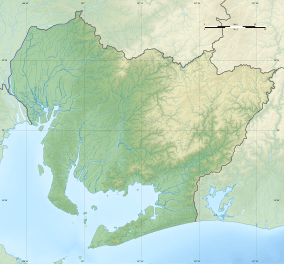Toyokawa Inari
Toyokawa Inari (豊川稲荷) is the popular name for a Buddhist temple of the Sōtō sect located in the city of Toyokawa in eastern Aichi Prefecture, Japan. The temple’s true name is 妙厳寺 (Myōgon-ji), or full name is Enpukuzan Toyokawa-kaku, Myōgon-ji (円福山 豊川閣 妙厳寺). Despite the torii gate at the entrance, and the popular identification of its main image of veneration (a Senju Kannon) with Inari Okami, the Shinto kami of fertility, rice, agriculture, industry and worldly success, the institution is a Buddhist temple and has no overt association with the Shinto religion.
| Toyokawa Inari 豊川稲荷 | |
|---|---|
Toyokawa Inari's main hall | |
| Religion | |
| Affiliation | Buddhism |
| Deity | Senju Kannon |
| Rite | Sōtō |
| Location | |
| Location | 1 Toyokawa-chō, Toyokawa, Aichi |
| Country | Japan |
 Toyokawa Inari  Toyokawa Inari (Japan) | |
| Geographic coordinates | 34°49′28.26″N 137°23′31.24″E |
| Architecture | |
| Founder | Tōkai Gieki |
| Completed | 1441 |
| Website | |
| Official website | |
History
The temple was founded in 1441 by a Buddhist priest named Tōkai Gieki (東海義易), whose distant predecessor, Kangan Giin had studied Tantric Buddhism in Song Dynasty, China .[1] Per his teachings, Juichimen Kannon was identified as an avatar of the Toyokawa Dakinishinten,[2] who is depicted in Japanese Buddhist iconography as a female deity riding on a white fox. In the period of Shinbutsu shūgō, the line between Buddhism and Shinto was blurred, and images of a goddess on a fox were associated with Ukanomitama-no-mikoto, the goddess of agriculture, who used the white fox as her messenger.[3]
The temple was patronized in the Sengoku period by Imagawa Yoshimoto, Oda Nobunaga, Toyotomi Hideyoshi and Tokugawa Ieyasu, and by pilgrims from the merchant classes in the Edo period through the modern period.
Cultural Properties
Most of the temple was rebuilt in the Meiji period or later; however, the Sanmon dates from 1536 and is the oldest existent buildings in the complex. The Main Hall was reconstructed in the Tempo period (1830-1843), and several other buildings also date from the Edo period. In terms of registered cultural properties, the temple has a wooden Kamakura period statue of Jizō Bosatsu which is a National Important Cultural Property.
Tōkai Hundred Kannon
The Toyokawa Inari combines with the Mino Thirty-three Kannon in Gifu Prefecture, the Owari Thirty-three Kannon in western Aichi Prefecture, and the Mikawa Thirty-three Kannon (三河三十三観音) in eastern Aichi Prefecture to form a pilgrimage route known as the Tōkai Hundred Kannon.[4]
See also
| Wikimedia Commons has media related to Toyokawa Inari. |
References
- Smyers, Karen Ann. The fox and the jewel: shared and private meanings in contemporary Japanese. University of Hawaii Press (1998). ISBN 0-8248-2102-5
Notes
- Toyokawa Inari Homepage Archived 2009-03-17 at the Wayback Machine. Toyokawa Inari. Accessed May 3, 2009.
- Owari Thirty-three Kannon Archived 2009-02-21 at the Wayback Machine. Aruku88.net. Accessed May 4, 2009.